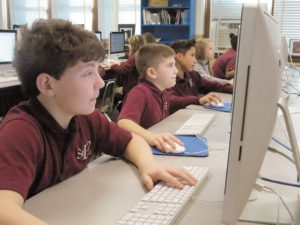Dialog reporter
WILMINGTON — On an early December morning, first-grade students at St. Elizabeth School laughed as they helped program an electronic ball to follow a taped path along the floor of their classroom. Upstairs, sixth-graders played around with one of the most recognizable pieces of art of their generation, the Google logo, making it sing and dance, changing its shape and colors.
It was all part of the annual Hour of Code, the nationwide initiative to get students interested in and aware of the role computers and coding plays in their daily lives, whether at home, school or work. The program is in its fourth year, and this was the third time St. Elizabeth has taken part. For the first time, the school involved every student from pre-kindergarten through high school.

Code.org, the nonprofit organization that sponsors the Hour of Code, wants more students, particularly women and minorities, to consider careers in computer science. Kammas Kersch, the science department chairperson at St. Elizabeth, said there is a shortage nationally of qualified people to fill jobs. That is true in Delaware as well.
“There’s such a deficit of people capable of filling jobs that are available that if we aren’t providing these opportunities to our students, we are really doing them a disservice. We need to be preparing them for not only the jobs that are available now, but the jobs that are available in the future,” she said.
“Research shows that if we introduce it to them at K-12, they’re a lot more likely to be willing to consider it going forward.”
The average salary for a computer scientist in Delaware, Kersch added, is $95,000.
The teachers on the December day were the 24 students enrolled in AP computer science, which is being offered for the first time this year at St. Elizabeth. Senior Noah Marchiafava wandered around a classroom full of sixth-graders helping them make the Google logo do whatever they wanted it to do. He noted that the students were involved in the process and having fun and that they could do this for a living.
“There’s a lot of jobs out there that you can get after high school and college in computer science,” Marchiafava said. “It’s a good thing to know, how to use computers. It helps your knowledge on electronics and it helps you with your phone. It helps you just understand better how computers run. To me, that’s something everybody should have the gist of at least.”
One of the sixth-grade students, Mackenzie Hilferty, said she uses her phone a lot, and knowing some basic coding could come in handy, although she’s not currently thinking of this as a career.
“I think it’s fun to do coding. It will be fun to do it when you have free time and you could do more things,” Mackenzie said.
Her classmate, Samantha Harrington, likes the idea that she can visit the Hour of Code website and find pick from the various projects to continue learning on her own.
“Once you get to learn it, it gets to be easier,” she said.
Kersch was encouraged by the positive response around the school and is determined that the education would last more than that one hour.






